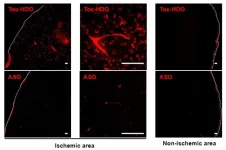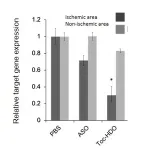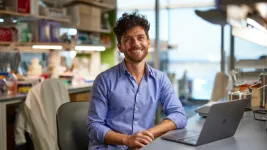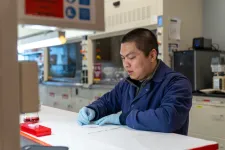Lipid molecules help to get stroke therapies into the brain
2023-04-17
(Press-News.org)
Researchers from Tokyo Medical and Dental University (TMDU) find that, when a stroke therapy is linked to a specific kind of lipid and injected into the blood, it is taken up preferentially in the stroke-lesioned brain
Tokyo, Japan – To get therapies into the brain after a stroke, researchers are increasingly making use of the blood–brain barrier, which allows only certain molecules to pass from the blood into the brain. In a study published earlier this year in Molecular Therapy, Japanese researchers have found that antisense oligonucleotides—specialized molecules that can modulate RNA and alter protein production—are preferentially taken up from the blood into areas of stroke damage when they’re linked to a specific kind of lipid known as α-tocopherol (TOC).
Current stroke therapies are only effective if they are delivered within a short window of time, which limits their effectiveness in many patients. Many new therapies are being investigated that can be applied outside this short window of opportunity. One such therapy involves the use of antisense oligonucleotides, which can be targeted to increase the production of beneficial proteins after a stroke, for example, or to decrease the production of harmful proteins. However, getting these molecules into the right area at the right time can be difficult, something that the researchers at Tokyo Medical and Dental University wanted to address.
“We’ve recently developed an antisense oligonucleotide known as a DNA/RNA heteroduplex oligonucleotide, or HDO,” says senior author of the study Takanori Yokota. “To see how different lipids affect the uptake of HDO in the brain, we linked it to either cholesterol or TOC and then injected it into the blood of mice who had been given an experimentally induced stroke in just one side of the brain.”
Unexpectedly, the TOC-linked molecules were observed at very high levels in the stroke-lesioned side of the brain only, whereas the cholesterol-linked molecules were high in both sides of the brain. This suggests that TOC specifically increases HDO uptake after stroke, while cholesterol does not. Furthermore, because HDO can be tailored to target different genes, it was used to silence a gene known to be beneficial in stroke. As expected, the researchers observed greater areas of stroke-related damage in the mice treated with this TOC-linked HDO.
“Together, our findings suggest that TOC-linked HDO is safe to use and is preferentially taken up and incorporated into cells in areas of stroke damage,” says Yokota. “This delivery method is potentially very useful for the targeted up- or down-regulation of protein expression after stroke.”
Given the relative lack of stroke therapies targeting the pathological processes that happen after a stroke, the current findings are very important. Increasing anti-inflammatory proteins and/or lowering inflammatory proteins in the stroke-lesioned brain is a promising way to avoid secondary damage to the brain after a stroke has occurred, and will lead to reductions in stroke-related disabilities.
###
The article, “Preferential delivery of lipid-ligand conjugated DNA/RNA heteroduplex oligonucleotide to ischemic brain in hyperacute stage,” was published in Molecular Therapy at DOI: 10.1016/j.ymthe.2023.01.016
END
[Attachments] See images for this press release:


ELSE PRESS RELEASES FROM THIS DATE:
2023-04-17
BEER-SHEVA, Israel, April 17, 2023 – Scientific research must meet clear ethical guidelines to prevent harm to participants. However, research can also indirectly harm individuals and social groups, for example by shaping social perceptions and inspiring policy. Researchers receive little to no training on how to consider and minimize such harm.
To that end, Ben-Gurion University of the Negev's Dr. Niv Reggev and his international colleagues have published ten simple rules for socially responsible science. The ...
2023-04-17
In parts of California’s iconic mountainous coasts, breathtaking beauty is punctuated by brusque signs warning spectators to stay back from unstable cliffs. The dangers of coastal erosion are an all-too-familiar reality for the modern residents of these communities. Now, with a new tool, researchers are bringing historical perspective to the hotly debated topic of how to manage these disappearing coastlines.
Using a model that incorporates measurements of the amount of time coastal cliffs and their remnant deposits were exposed at the Earth’s surface, Stanford researchers found that the rate of cliff erosion in the past 100 years is ...
2023-04-17
People living with long Covid who suffer from loss of smell show different patterns of activity in certain regions of the brain, a new study led by UCL researchers has found.
The research used MRI scanning to compare the brain activity of people with long Covid who lost their sense of smell, those whose smell had returned to normal after Covid infection, and people who had never tested positive for Covid-19.
Published in eClinicalMedicine, the observational study found that the people with long Covid smell loss had reduced brain activity and impaired communication between two parts of the brain which process ...
2023-04-17
SAN ANTONIO — April 17, 2023 —Southwest Research Institute staff members have converged upon Detroit this week to share their respective expertise with the mobility industry at the 2023 SAE International WCX™ World Congress Experience.
WCX is the “largest technical mobility event developed by the industry, for the industry,” according to SAE. The conference, which takes place April 17-20, invites mechanical, electrical and software engineers working in mobility from around the world to share knowledge and research to overcome the latest challenges facing the industry.
As leaders in mobility and automotive research, ...
2023-04-17
Through careful crossbreeding and selection, University of Maryland researchers have developed what may just be the perfect apples for American growers trying to adapt to a changing world. The two new apples, a yellow and a red one are heat-tolerant, blight-tolerant, low-maintenance, easy to harvest and not least, delicious-tasting. Both have been approved for patents and are awaiting the final grant from the U.S. Patent Office.
They address a growing suite of problems the apple industry has been grappling with. The fruit has always been labor-intensive to bring to market, with trees that need to be trained, pruned, ...
2023-04-17
Barcelona, Spain – 17 April 2023: Thirty day electrocardiogram (ECG) monitoring in patients with hypertrophic cardiomyopathy (HCM) detects more arrhythmias than the standard 24 to 48 hours, according to late breaking science presented at EHRA 2023, a scientific congress of the European Society of Cardiology (ESC).1
Up to 20% of patients with HCM develop atrial fibrillation during the course of the disease2,3 and are at particularly high risk of stroke. Therefore, guidelines do not recommend the CHA2DS2-VASc score4 to calculate stroke risk but advise starting anticoagulant treatment in all patients with HCM ...
2023-04-17
Edward Chouchani receives a Vilcek Prize for Creative Promise in Biomedical Science for his work to decipher the molecular mechanisms that drive metabolic disease, with the aim of developing therapeutic interventions.
The Vilcek Prize for Creative Promise is a $50,000 recognition awarded annually by the Vilcek Foundation as part of its prizes program. Awarded annually since 2006, the Vilcek Foundation prizes recognize and celebrate immigrant contributions to scientific research and discovery, and to artistic and cultural advancement in the United States. The Vilcek Foundation prizes support the Vilcek Foundation’s mission to raise public awareness of the value ...
2023-04-17
A parabolic dish on the EPFL campus is easily overlooked, resembling a satellite dish or other telecommunications infrastructure. But this dish is special, because it works like an artificial tree. After concentrating solar radiation nearly 1,000 times, a reactor above the dish uses that sunlight to convert water into valuable and renewable hydrogen, oxygen, and heat.
“This is the first system-level demonstration of solar hydrogen generation. Unlike typical lab-scale demonstrations, it includes all auxiliary devices and components, so it gives us a better idea of the energy efficiency you can expect ...
2023-04-17
Using a new detection method, UC Riverside scientists found a massive amount of methane, a super-potent greenhouse gas, coming from wildfires — a source not currently being accounted for by state air quality managers.
Methane warms the planet 86 times more powerfully than carbon dioxide over the course of 20 years, and it will be difficult for the state to reach its required cleaner air and climate goals without accounting for this source, the researchers said.
Wildfires emitting methane ...
2023-04-17
McMaster University researchers have developed a rapid and inexpensive test for Salmonella contamination in chicken and other food – one that’s easier to use than a home COVID test.
The test, described in a new paper in the journal Angewandte Chemie, could improve food safety, reduce the cost of processing fresh poultry and other foods, and help to limit broad recalls to batches that have specifically been identified as contaminated.
The researchers have shown that the test provides accurate results in an hour or less without the need for accessories or a power source, compared ...
LAST 30 PRESS RELEASES:
[Press-News.org] Lipid molecules help to get stroke therapies into the brain







